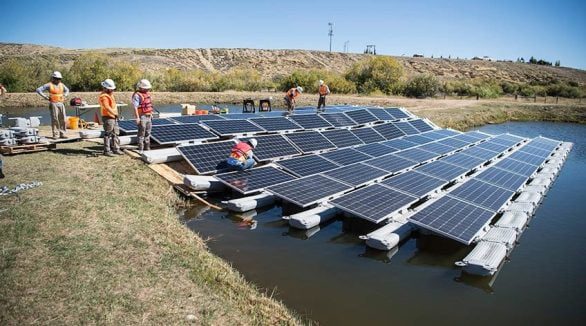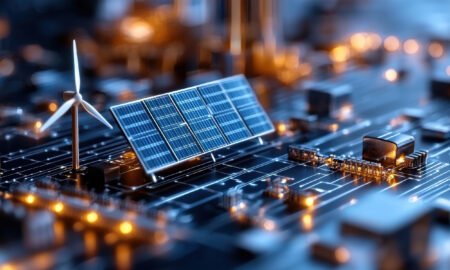As the global demand for renewable energy grows, solar power has emerged as a dominant solution to meet sustainability and decarbonization targets. However, in many regions around the world, the scarcity of land and water resources presents significant barriers to large-scale solar energy deployment. Water-poor regions, especially those facing water scarcity, require innovative solutions to balance the need for clean energy with the necessity of water conservation.
Floating solar photovoltaics (FPV) offer a promising way forward, utilizing bodies of water for energy generation without taking up valuable land. This article explores how FPV can be an ideal solution for water-poor regions, discussing its potential benefits, challenges, and real-world examples.
The Intersection of Water Scarcity and Solar Power
Water scarcity is one of the most pressing global challenges, particularly in regions such as the Middle East, North Africa, parts of Asia, and the southwestern United States. With climate change exacerbating droughts and increasing the pressure on freshwater supplies, many countries are seeking sustainable ways to produce energy without further straining their water resources.
At the same time, these regions are often highly dependent on energy-intensive, water-consuming methods such as desalination plants for drinking water and thermoelectric power plants for electricity generation. These methods require vast amounts of freshwater, creating a direct conflict between energy generation and water conservation.
In this context, floating solar presents an innovative solution that aligns with both energy and water conservation goals. By deploying solar panels on bodies of water such as lakes, reservoirs, and even offshore areas, FPV systems can produce clean energy while simultaneously reducing evaporation from the water surface, aiding in water conservation.
The Benefits of Floating Solar in Water-Poor Regions
Floating solar systems offer several compelling advantages for water-poor regions:
1. Water Conservation
The most significant benefit of FPV in water-scarce regions is its ability to reduce water evaporation from reservoirs, lakes, and other bodies of water. In hot, arid climates, evaporation from open water surfaces can be a substantial source of water loss. By covering a portion of the water surface with floating solar panels, evaporation rates can be reduced by up to 70% or more.
This effect is particularly important in regions where water is already in short supply, such as parts of the Middle East and the southwestern United States. For example, in California, the Alameda County Water District has experimented with floating solar arrays on water reservoirs to combat evaporation and reduce water loss, demonstrating the dual benefit of energy generation and water conservation.
2. Land Use Efficiency
In water-scarce regions, finding suitable land for large-scale solar projects can be challenging. High population density, limited available land, and competing land uses (such as agriculture or urban development) restrict the deployment of ground-mounted solar installations.
Floating solar solves this problem by utilizing underexploited bodies of water, which are abundant in many areas but often not fully utilized for productive purposes. For instance, India, a country experiencing both rapid urbanization and water stress, has embraced floating solar technology on reservoirs to meet its growing energy demand without sacrificing valuable land for food production or housing.
3. Improved Solar Efficiency
One of the primary technical advantages of floating solar systems is their ability to take advantage of the cooling effects of water. Solar panels typically experience reduced efficiency as they heat up under the sun, but floating solar panels are naturally cooled by the water beneath them. This temperature regulation can increase the overall energy efficiency of FPV systems by up to 15%, particularly in areas with hot climates.
As a result, floating solar arrays are ideal for regions where solar energy production is high but where temperatures also tend to be elevated, which can be the case in many water-poor regions like the Middle East, India, and parts of Africa. The natural cooling effect from the water body enhances energy production and makes FPV a more attractive option in hot climates.
4. Environmental Co-Benefits
Floating solar installations offer environmental co-benefits, especially in water-scarce regions that may also face challenges related to water quality and ecosystem health. For example, floating solar arrays can help reduce algae growth and water contamination by limiting the amount of sunlight that penetrates the water surface. This can result in better water quality, reduced nutrient loading, and healthier ecosystems.
In Brazil, a 1.1 MW floating solar installation on a reservoir has shown promise in improving water quality by preventing algae blooms that can occur in warm, nutrient-rich water bodies. Such benefits are particularly relevant in areas where water quality degradation is a concern.
Real-World Applications: How FPV is Addressing Water Scarcity
Several projects around the world are already demonstrating how floating solar can address water scarcity while promoting renewable energy.
1. California, USA: Addressing Drought with FPV
California, a state that frequently experiences droughts, is turning to floating solar technology to address both its energy and water needs. The Alameda County Water District partnered with Sungrow Power to install floating solar panels on a water reservoir, effectively reducing water evaporation while generating clean electricity.
This project, known as the Alameda Floating Solar Array, has shown that FPV systems can be successfully deployed in regions with significant water stress, offering a dual solution to both energy generation and water conservation. The system not only helps preserve water in the reservoir but also supplies clean power to the local grid, supporting California’s ambitious renewable energy goals.
2. India: Harnessing Floating Solar to Conserve Water
India is facing significant water stress, with many of its river basins experiencing severe depletion. The country is also striving to meet its renewable energy targets and reduce dependence on coal-fired power plants. To address both challenges, India has deployed several floating solar projects on its vast network of reservoirs.
One notable project is located at the Tungabhadra Dam in Karnataka, where a 1 MW floating solar system was installed to reduce evaporation from the reservoir and produce clean energy. In addition to conserving water, this FPV system helps the state meet its renewable energy targets while avoiding the use of valuable agricultural land for solar panels.
Another key project in India is the 10 MW floating solar farm on the Ramgarh Lake in Hyderabad, developed by Azure Power. This project further demonstrates how FPV can address land scarcity and water conservation simultaneously, offering a sustainable solution for the country’s energy needs.
3. Middle East: Addressing Water Scarcity with Dual-Use FPV Systems
The Middle East, one of the world’s most water-scarce regions, is increasingly turning to floating solar technology as part of its efforts to conserve water and expand renewable energy capacity. Countries like United Arab Emirates (UAE), Saudi Arabia, and Qatar are all exploring FPV as a means to reduce water loss from reservoirs while also capitalizing on the abundant sunlight in the region.
In UAE, the Mohammed bin Rashid Al Maktoum Solar Park has tested floating solar systems as part of its wider strategy to diversify its renewable energy portfolio. These projects, though still in the pilot phase, demonstrate the potential of FPV to meet the country’s energy demands while preserving water resources.
In Saudi Arabia, which is heavily reliant on desalination plants for drinking water, FPV systems on reservoirs are being considered to minimize evaporation and improve energy efficiency. Given the high temperatures and water stress in the region, FPV offers a promising solution for both water conservation and renewable energy production.
Challenges and Considerations for Floating Solar in Water-Poor Regions
While FPV systems offer numerous benefits for water-scarce regions, several challenges remain:
- High Initial Costs: The capital costs of floating solar systems, including specialized floating platforms and anchoring systems, are generally higher than traditional land-based solar projects. However, the potential long-term savings in water conservation and operational efficiencies may offset these initial costs.
- Regulatory Hurdles: Many water-scarce regions may not have the regulatory frameworks in place to support floating solar development. Clearer policies and incentives are needed to foster investment in FPV systems.
- Environmental and Social Impacts: While FPV is generally considered environmentally friendly, concerns about the potential disruption to aquatic ecosystems, such as fish habitats or water quality, need to be addressed. Thorough environmental assessments are essential before deploying FPV projects.
Conclusion: A Viable Solution for the Future
Floating solar photovoltaics provide a viable and innovative solution to the dual challenges of water scarcity and renewable energy deployment in water-poor regions. By utilizing water bodies for energy generation, FPV systems can contribute to clean energy targets while helping conserve precious water resources. As the technology continues to evolve and costs decrease, FPV will likely become a key tool for achieving sustainability goals in regions where water is a scarce and precious resource.
With real-world applications already demonstrating its potential, FPV offers a new era of renewable energy that can provide both clean electricity and environmental co-benefits for water-scarce regions across the globe.











